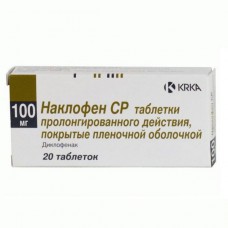Expiration date: 04/2026
The composition and form of issue:
1 g gel contains the diethylammonium salt of diclofenac 11, 6 mg (equivalent to 10 mg of diclofenac) in tubes of 60 grams in a box 1 tuba.
1 tablet coated liner contains diclofenac sodium 50 or 100 mg (retard) in a contour acheikova packing 10 PCs., in box 2 packaging.
1 vial 3 ml solution for injection 75 mg in a box 5 PCs
1 suppository rectally 50 mg in a contour bezgyachakova packing 5 PCs., in box 2 packaging.
Pharmacological action:
Blocks cyclooxygenase and inhibits the synthesis of GHGs.
Pharmacokinetics:
Once inside absorbed more than 90%, bioavailability is 60%. Cmax achieved through 1-4 h (with the/m introduction — 30 min., with rectal after 1 hour). Linking plasma protein — 99, 5%. T1/2 — 1-2 hours Virtually completely metabolized. Approximately 60% is excreted in the urine the remainder in the bile and feces. The gel is quickly absorbed and penetrates into the underlying tissues (subcutaneous tissue, muscle tissue, joint capsule and the joint cavity).
Description pharmacological action:
Anti-inflammatory effect is due to the interference at different stages of pathogenesis of inflammation: in addition to the main antiprostaglandin effect, normalizes the increased permeability, microcirculation, decreases the impact of histamine, bradykinin and other mediators of inflammation inhibited the formation of ATP, the reduced energy of the inflammatory process, etc. Analgesic properties are due to the ability to weaken algogennosti bradykinin, antipyretic — a calming influence changed under the influence of the pathological process teploreguliruth excitability of the centers of the diencephalon. Causes the weakening and disappearance of pain at the site of application of the gel, helps to increase range of motion.
Indications:
Inflammatory rheumatic diseases (rheumatoid arthritis, juvenile rheumatoid arthritis, seronegative spondylitis), degenerative diseases of joints and spine (arthrosis, spondylosis), arthritis caused by metabolic disorders (gout, pseudogout), extra-articular rheumatism (periarthritis, bursitis, myositis, tendonitis, synovitis), inflammatory and painful conditions of musculoskeletal system, dysmenorrhoea (primary and secondary), dental surgery, renal and biliary colic, soft tissue injuries, back pain, neck, muscles, shoulder, lower back, when osteochondrosis, radiculitis, bruises, sprains, muscles and tendons, inflammatory swelling of the soft tissues, sore muscles and joints, caused by heavy physical exertion.
Contraindications:
Hypersensitivity to salicylates, NSAIDs, etc., manifested as bronchial asthma, urticaria and rhinitis, active peptic ulcer or relapse of duodenal ulcer in the anamnesis, children's age (up to 1 year, gel to 6 years), the mucosal anorectal or rectal bleeding (suppositories).
Application of pregnancy and breast-feeding:
Not recommended (especially in the last trimester of pregnancy).
Side effects:
Abdominal pain, constipation, heartburn, nausea, and rarely with long-term therapy — peptic ulcer or gastrointestinal bleeding, rarely — peripheral edema, fatigue, dizziness, asymptomatic increase in liver function tests, allergic reactions (rash, itching), hives, increased asthma attacks, angioedema local: redness or burning sensation (gel).
Drug interactions:
Increases concentration in the blood serum of the drugs lithium and digoxin. Reduces the diuretic effect of diuretics and potentiates hyperkalemia when combined with potassium-sparing diuretics. Joint appointment. NSAIDs increases the risk of side effects.
Method of application and dose:
Inside, not liquid, during or immediately after a meal.
Adults — 100 to 150 mg/day (1 table. 50 mg 2-3 times or 1 tab. retard 100 mg once).
N/a. severe pain (including renal colic) — 75 mg 1-2 times a day (again, after 30 minutes or more). Children older than 1 year — 1-3 mg/kg/day in 2-3 reception.
Cutaneous, put a strip of gel 5-10 cm 3-4 times per day and gently massaged. The course of treatment is from 2 to 4 weeks.
Precautions:
With caution is prescribed for ulcerative colitis and Crohn's disease, severe hepatic, renal or heart failure patients with diseases of upper gastrointestinal tract in the anamnesis should be used under strict medical supervision.


